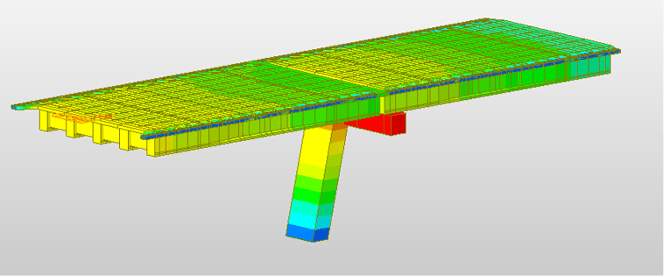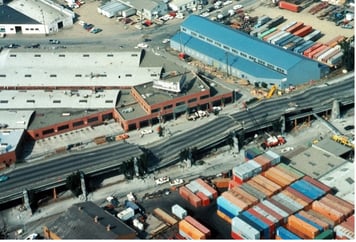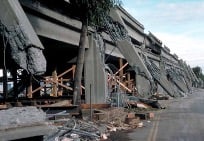The Importance of Seismic Analysis and Its Understanding

Author: MIDASoft
Publish Date: 31 Mar, 2022
The seismic analysis is part of the structural analysis and the calculation of the response of a structure to earthquakes. It is part of the structural design process, evaluation, and retrofit in seismic zones.

Figure 1. Deformation of PSC bridge under seismic loading
Earlier, bridges were not emphasized with the seismic designs, but in the coming time it has been observed that for a seismic-prone area, seismic design can be the governing factor. Also, when the bridge is subjected to seismic load and reaches the non-linear range, the redistribution of forces comes into the picture, which should be accounted for. This article will focus on the general understanding of the type of seismic analysis that can be performed.
Why is seismic analysis important?
The seismic analysis allows us to visualize the response of a bridge during an earthquake, which enables us to obtain the additional forces or deformations that would be generated because of an earthquake. The forces can be of the following types:
- Lateral loads applied by the earthquake
- Vibration loads
- Additional forces due to the P-Delta effect
- Non-linear behavior of steel and concrete
If we talk about the earthquake effect concerning bridges, then earthquakes lead to vertical and horizontal ground motions that can result in the failure of bridges. The most common damage includes shear-flexural failure of the bridge pier columns, expansion joint failure, shear key failure, and girder sliding in the transverse or longitudinal directions due to weak connections between girders and bearings. In addition, both the vertical and horizontal ground motions may cause the liquefaction of the soil at the bridge foundations, which can greatly reduce the load-carrying capacity of the foundations leading to the bridge collapse.
. 

Figure 2: The collapsed Cypress Street Viaduct in Oakland, California due to an earthquake in 1989. (Author H.G. Wilshire, U.S. Geological Survey )
Hence, it becomes essential to emphasize on seismic design of bridges. For that, we must understand the seismic analysis classification. Seismic analysis can be classified based on the nature of the load applied, i.e., whether the load applied is static or dynamic. Again, it can also be categorized based on the structure's response, i.e., whether it is elastic or non-linear. With that, the analysis considered is presented below:

In the case of static analysis, the seismic load is represented by a static load applied in the direction lateral to the structure. It is relatively simple to apply, and analysis is also fast. While dynamic analysis is the more accurate simulation of seismic loading, its application is relatively complex.
Equivalent Force Method
The equivalent force method is a simplified technique to substitute the effect of dynamic loading of an expected earthquake by a static force distributed laterally on a structure for design purposes. It is an elastic type; hence the non-linear behavior of the structure is not accounted for.
Response Spectrum Analysis
Before understanding response spectrum analysis, it is important to understand what it means by response spectrum:
Response Spectrum is a plot of the peak or steady-state response (displacement, velocity, or acceleration) of a series of oscillators of varying natural frequencies that are forced into motion by the same base vibration or shock. So, the dynamic analysis of a structure subjected to earthquake excitation can be performed using the response spectrum function.
Before performing the response spectrum analysis, eigenvalue analysis is necessary through which we get the structure period of vibration, modes, and modal mass, after which we proceed towards response spectrum analysis:
-2.png?width=712&name=image%20(10)-2.png)
-2.png?width=716&name=image%20(11)-2.png)
Figure 3: Modal results obtained after performing Eigen value analysis
.png?width=631&name=image%20(12).png)
Figure 4: Process of response spectrum analysis
For seismic design, we obtain the acceleration values corresponding to the natural period of the structure obtained through the eigenvalue analysis from this spectrum. This value can be obtained from the maximum deformation of the structure.
Pushover Analysis
Pushover analysis is a non-linear analysis to assess the structural capacity under static horizontal loads growing until the collapse of the structure. The results of the pushover analyses are capacity curves identified by the variation of the base shear in the function of the displacement of a control point on the structure.
.png?width=589&name=image%20(13).png)
Figure 5: Pushover curve obtained for a bridge pier in midas civil
It is also called static non-linear analysis; because it is a method in which the action is static, but the structure behavior is non-linear.
Additional Purpose:
- Pushover analysis is used to estimate ductility and over-strength of the structure.
- It also gives the idea of possible places where hinge formation can take place
Hinges: To consider the non-linearity in the structure, hinges must be defined:
.png?width=496&name=image%20(14).png)
Figure 6: Hinges location for a beam
Hinges follow the property defined, and as the load increment is done, the plastic region is reached, and non-linear behavior is simulated. Pushover hinges can be defined in midas Civil as shown below:
.png?width=500&name=image%20(15).png)
Figure 7: Definition of hinges in midas Civil
Time History Analysis
Time history analysis is a step-by-step analysis of the dynamic response of a structure to a specified loading that may vary with time. Since this analysis considers dynamic loading, it is the most accurate but a bit complex in terms of application. The load application considers a ground motion as shown below:
-1.png?width=533&name=image%20(16)-1.png)
Figure 8: Time history function for EL Centro defined in midas Civil
The response of the structure varies with applied ground motion; hence the complexity of the time history analysis also lies in the selection of the ground motions to be considered.
Conclusion
So, by going through this article, we've understood the different kinds of analysis that can be performed for seismic design. The accuracy, computational time, and application vary for all. But the bottom line remains that the seismic design is essential for a bridge, just like the standard design, as the governing factor for design often turns out to be seismic loads.



Add a Comment